wheel NISSAN MAXIMA 2023 Owners Manual
[x] Cancel search | Manufacturer: NISSAN, Model Year: 2023, Model line: MAXIMA, Model: NISSAN MAXIMA 2023Pages: 494, PDF Size: 5.7 MB
Page 470 of 494
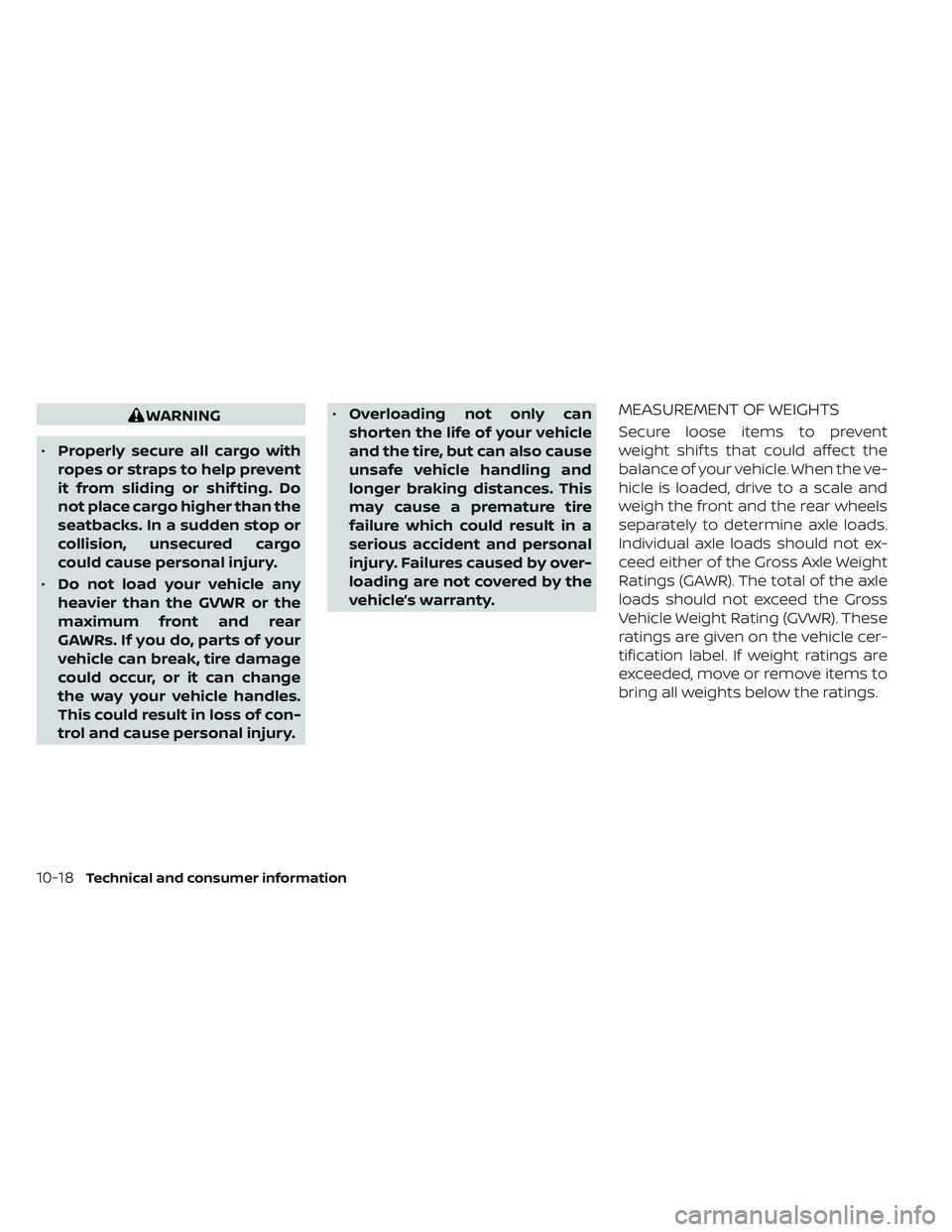
WARNING
• Properly secure all cargo with
ropes or straps to help prevent
it from sliding or shif ting. Do
not place cargo higher than the
seatbacks. In a sudden stop or
collision, unsecured cargo
could cause personal injury.
• Do not load your vehicle any
heavier than the GVWR or the
maximum front and rear
GAWRs. If you do, parts of your
vehicle can break, tire damage
could occur, or it can change
the way your vehicle handles.
This could result in loss of con-
trol and cause personal injury. •
Overloading not only can
shorten the life of your vehicle
and the tire, but can also cause
unsafe vehicle handling and
longer braking distances. This
may cause a premature tire
failure which could result in a
serious accident and personal
injury. Failures caused by over-
loading are not covered by the
vehicle’s warranty.MEASUREMENT OF WEIGHTS
Secure loose items to prevent
weight shif ts that could affect the
balance of your vehicle. When the ve-
hicle is loaded, drive to a scale and
weigh the front and the rear wheels
separately to determine axle loads.
Individual axle loads should not ex-
ceed either of the Gross Axle Weight
Ratings (GAWR). The total of the axle
loads should not exceed the Gross
Vehicle Weight Rating (GVWR). These
ratings are given on the vehicle cer-
tification label. If weight ratings are
exceeded, move or remove items to
bring all weights below the ratings.
10-18
Technical and consumer information
Page 471 of 494
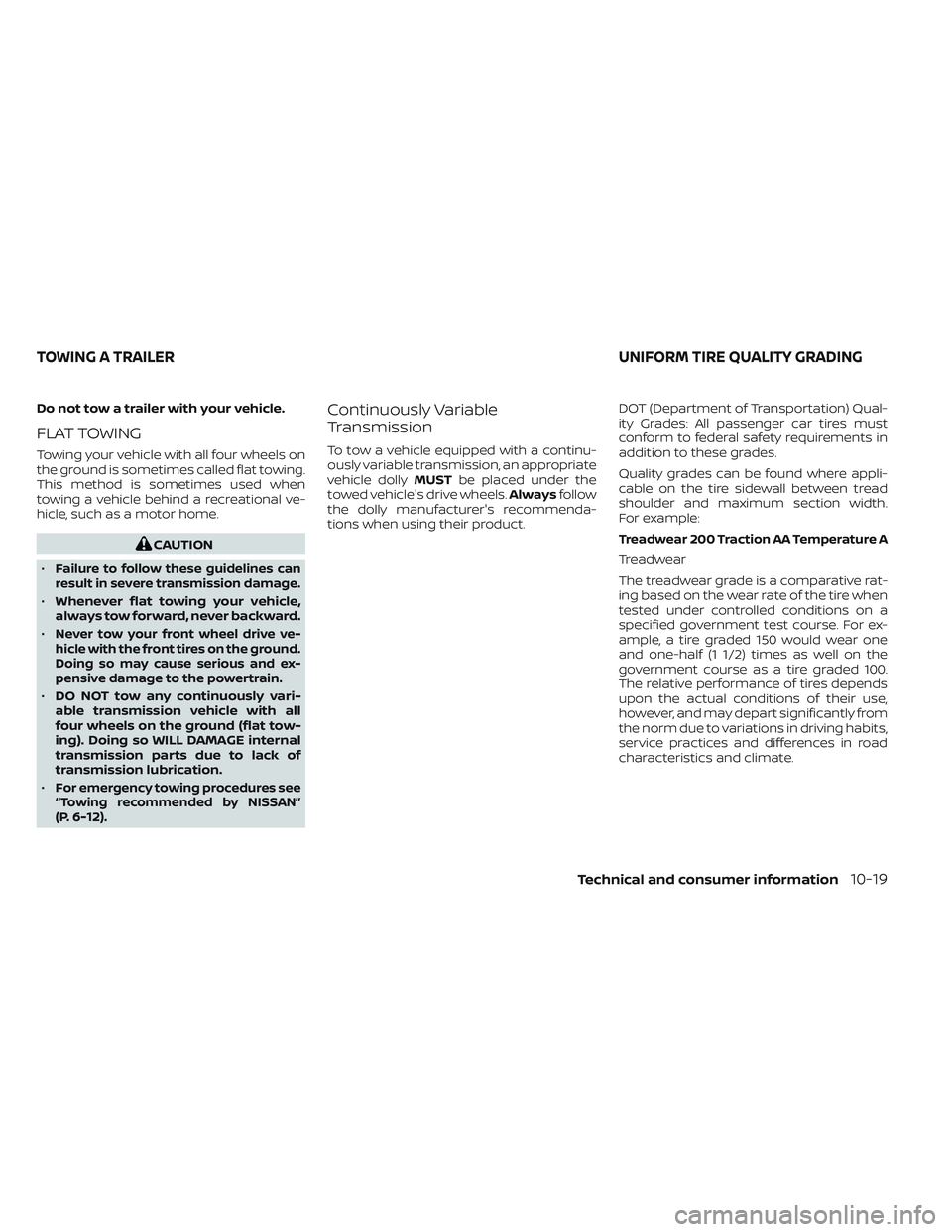
Do not tow a trailer with your vehicle.
FLAT TOWING
Towing your vehicle with all four wheels on
the ground is sometimes called flat towing.
This method is sometimes used when
towing a vehicle behind a recreational ve-
hicle, such as a motor home.
CAUTION
•
Failure to follow these guidelines can
result in severe transmission damage.
• Whenever flat towing your vehicle,
always tow forward, never backward.
•
Never tow your front wheel drive ve-
hicle with the front tires on the ground.
Doing so may cause serious and ex-
pensive damage to the powertrain.
• DO NOT tow any continuously vari-
able transmission vehicle with all
four wheels on the ground (flat tow-
ing). Doing so WILL DAMAGE internal
transmission parts due to lack of
transmission lubrication.
•
For emergency towing procedures see
“Towing recommended by NISSAN”
(P. 6-12).
Continuously Variable
Transmission
To tow a vehicle equipped with a continu-
ously variable transmission, an appropriate
vehicle dolly MUSTbe placed under the
towed vehicle's drive wheels. Alwaysfollow
the dolly manufacturer's recommenda-
tions when using their product. DOT (Department of Transportation) Qual-
ity Grades: All passenger car tires must
conform to federal safety requirements in
addition to these grades.
Quality grades can be found where appli-
cable on the tire sidewall between tread
shoulder and maximum section width.
For example:
Treadwear 200 Traction AA Temperature A
Treadwear
The treadwear grade is a comparative rat-
ing based on the wear rate of the tire when
tested under controlled conditions on a
specified government test course. For ex-
ample, a tire graded 150 would wear one
and one-half (1 1/2) times as well on the
government course as a tire graded 100.
The relative performance of tires depends
upon the actual conditions of their use,
however, and may depart significantly from
the norm due to variations in driving habits,
service practices and differences in road
characteristics and climate.
TOWING A TRAILER
UNIFORM TIRE QUALITY GRADING
Technical and consumer information10-19
Page 472 of 494
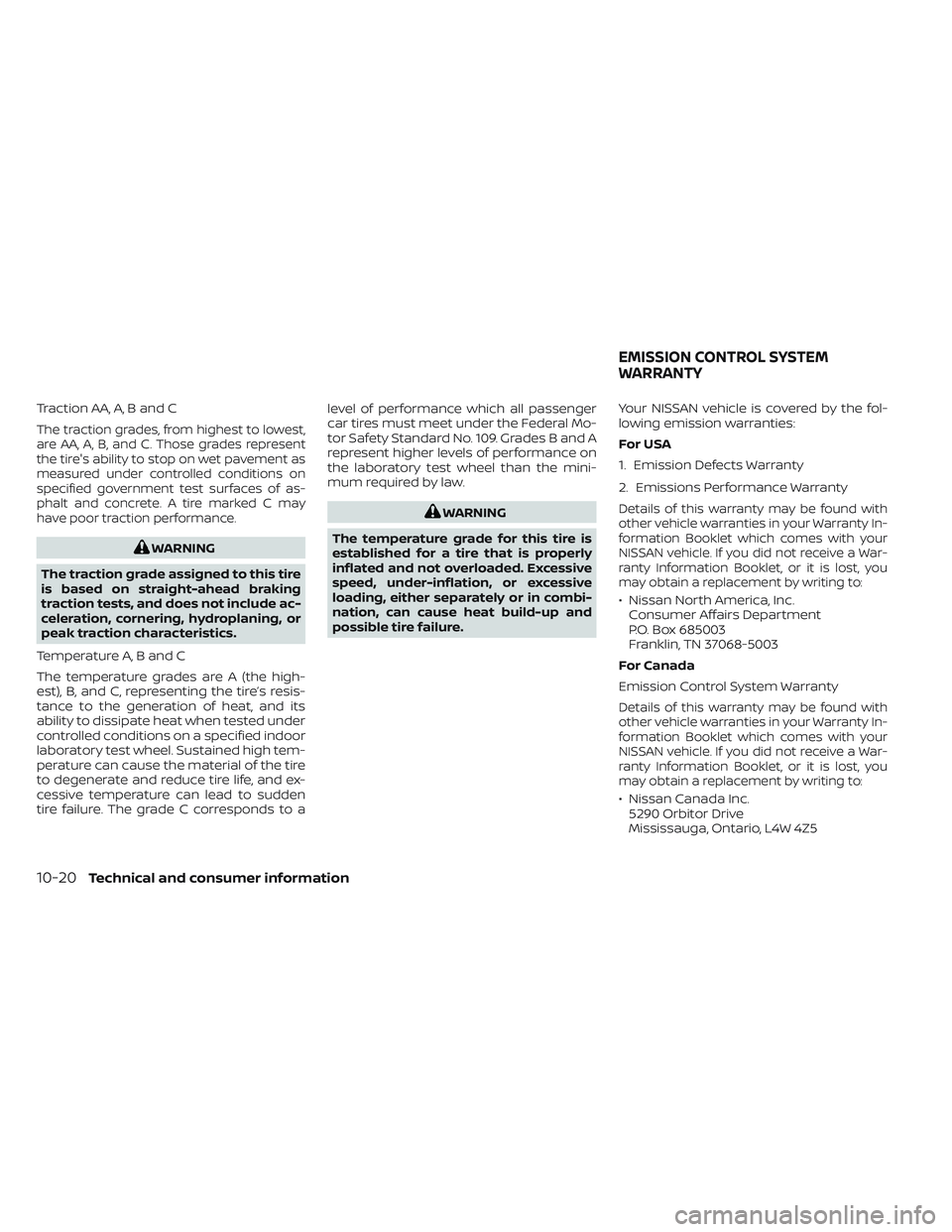
Traction AA, A, B and C
The traction grades, from highest to lowest,
are AA, A, B, and C. Those grades represent
the tire's ability to stop on wet pavement as
measured under controlled conditions on
specified government test surfaces of as-
phalt and concrete. A tire marked C may
have poor traction performance.
WARNING
The traction grade assigned to this tire
is based on straight-ahead braking
traction tests, and does not include ac-
celeration, cornering, hydroplaning, or
peak traction characteristics.
Temperature A, B and C
The temperature grades are A (the high-
est), B, and C, representing the tire’s resis-
tance to the generation of heat, and its
ability to dissipate heat when tested under
controlled conditions on a specified indoor
laboratory test wheel. Sustained high tem-
perature can cause the material of the tire
to degenerate and reduce tire life, and ex-
cessive temperature can lead to sudden
tire failure. The grade C corresponds to a level of performance which all passenger
car tires must meet under the Federal Mo-
tor Safety Standard No. 109. Grades B and A
represent higher levels of performance on
the laboratory test wheel than the mini-
mum required by law.
WARNING
The temperature grade for this tire is
established for a tire that is properly
inflated and not overloaded. Excessive
speed, under-inflation, or excessive
loading, either separately or in combi-
nation, can cause heat build-up and
possible tire failure. Your NISSAN vehicle is covered by the fol-
lowing emission warranties:
For USA
1. Emission Defects Warranty
2. Emissions Performance WarrantyDetails of this warranty may be found with
other vehicle warranties in your Warranty In-
formation Booklet which comes with your
NISSAN vehicle. If you did not receive a War-
ranty Information Booklet, or it is lost, you
may obtain a replacement by writing to:
• Nissan North America, Inc.
Consumer Affairs Department
P.O. Box 685003
Franklin, TN 37068-5003
For Canada
Emission Control System Warranty
Details of this warranty may be found with
other vehicle warranties in your Warranty In-
formation Booklet which comes with your
NISSAN vehicle. If you did not receive a War-
ranty Information Booklet, or it is lost, you
may obtain a replacement by writing to:
• Nissan Canada Inc. 5290 Orbitor Drive
Mississauga, Ontario, L4W 4Z5
EMISSION CONTROL SYSTEM
WARRANTY
10-20Technical and consumer information
Page 479 of 494
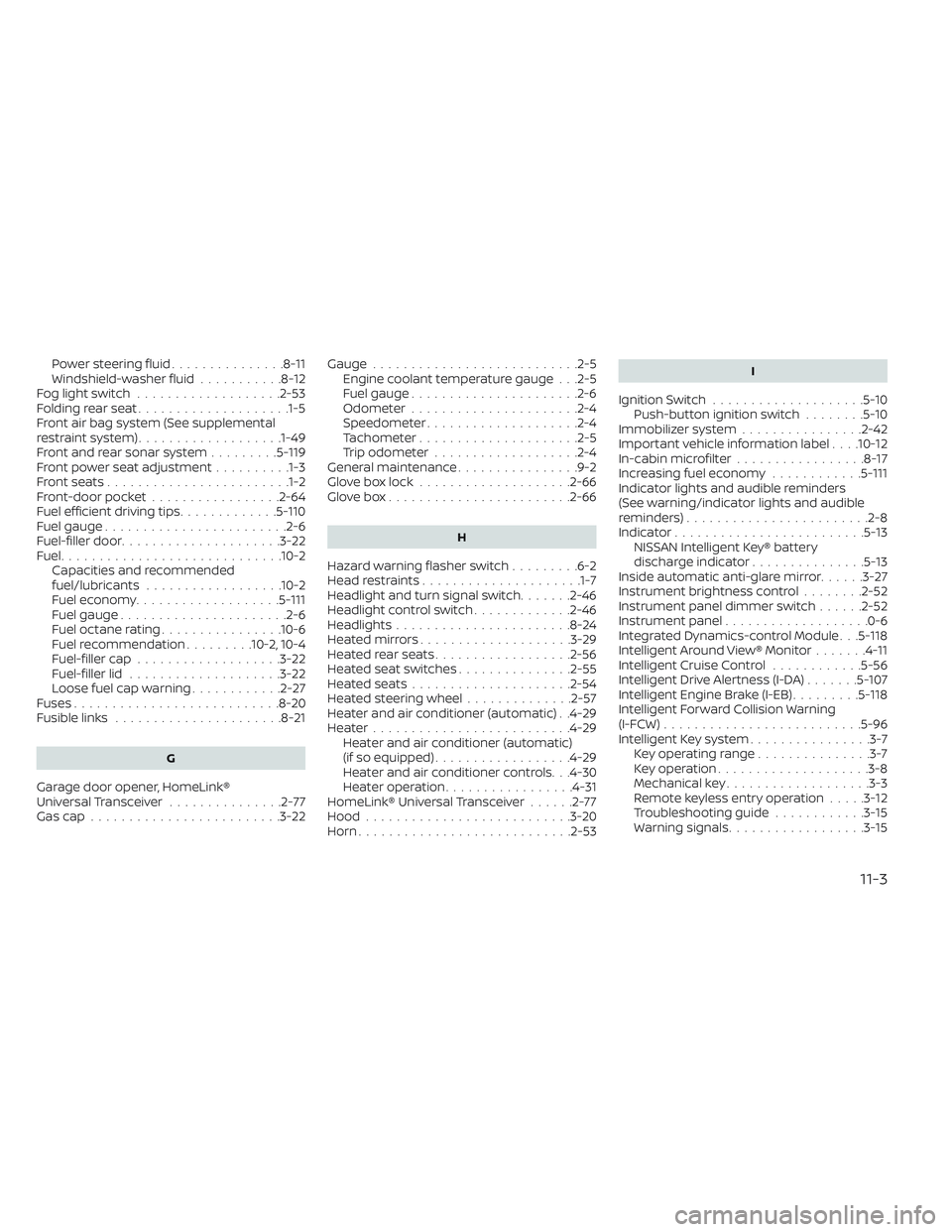
Powersteeringfluid...............8-11
Windshield-washer fluid...........8-12
Foglightswitch ...................2-53
Foldingrearseat................... .1-5
Front air bag system (See supplemental
restraint system) ...................1-49
Front and rear sonar system .........5-119
Front power seat adjustment ..........1-3
Frontseats....................... .1-2
Front-door pocket .................2-64
Fuelefficientdrivingtips.............5 -110
Fuel gauge ........................2-6
Fuel-filler door .....................3-22
Fuel.............................10-2 Capacities and recommended
fuel/lubricants ..................10-2
Fuel economy ...................5 -111
Fuel gauge ......................2-6
Fueloctanerating................10-6
Fuel recommendation .........10-2,10-4
Fuel-filler cap ...................3-22
Fuel-filler lid ....................3-22
Loose fuel cap warning ............2-27
Fuses ...........................8-20
Fusiblelinks ......................8-21
G
Garage door opener, HomeLink®
Universal Transceiver ...............2-77
Gascap.........................3-22 Gauge
...........................2-5
Engine coolant temperature gauge . . .2-5
Fuel gauge ......................2-6
Odometer ......................2-4
Speedometer ....................2-4
Tachometer .....................2-5
Trip odometer ...................2-4
General maintenance ................9-2
Gloveboxlock ....................2-66
Glovebox........................2-66
H
Hazard warning flasher switch .........6-2
Headrestraints.................... .1-7
Headlight and turn signal switch .......2-46
Headlightcontrolswitch.............2-46
Headlights.......................8-24
Heatedmirrors....................3-29
Heatedrearseats..................2-56
Heated seat switches ...............2-55
Heatedseats.....................2-54
Heated steering wheel ..............2-57
Heater and air conditioner (automatic) . .4-29
Heater..........................4-29 Heater and air conditioner (automatic)
(if so equipped) ..................4-29
Heater and air conditioner controls. . .4-30
Heater operation .................4-31
HomeLink® Universal Transceiver ......2-77
Hood ...........................3-20
Horn............................2-53
I
Ignition Switch ....................5-10
Push-button ignition switch ........5-10
Immobilizer system ................2-42
Important vehicle information label . . . .10-12
In-cabinmicrofilter.................8-17
Increasing fuel economy ............5-111
Indicator lights and audible reminders
(See warning/indicator lights and audible
reminders) ....................... .2-8
Indicator.........................5-13 NISSAN Intelligent Key® battery
discharge indicator ...............5-13
Inside automatic anti-glare mirror ......3-27
Instrument brightness control ........2-52
Instrument panel dimmer switch ......2-52
Instrument panel ...................0-6
Integrated Dynamics-control Module . . .5-118
Intelligent Around View® Monitor .......4-11
Intelligent Cruise Control ............5-56
Intelligent Drive Alertness (I-DA) .......5-107
Intelligent Engine Brake (I-EB) .........5-118
Intelligent Forward Collision Warning
(I-FCW)..........................5-96
Intelligent Key system ................3-7
Key operating range ...............3-7
Key operation ....................3-8
Mechanical key ...................3-3
Remote keyless entry operation .....3-12
Troubleshooting guide ............3-15
Warning signals ..................3-15
11-3
Page 482 of 494
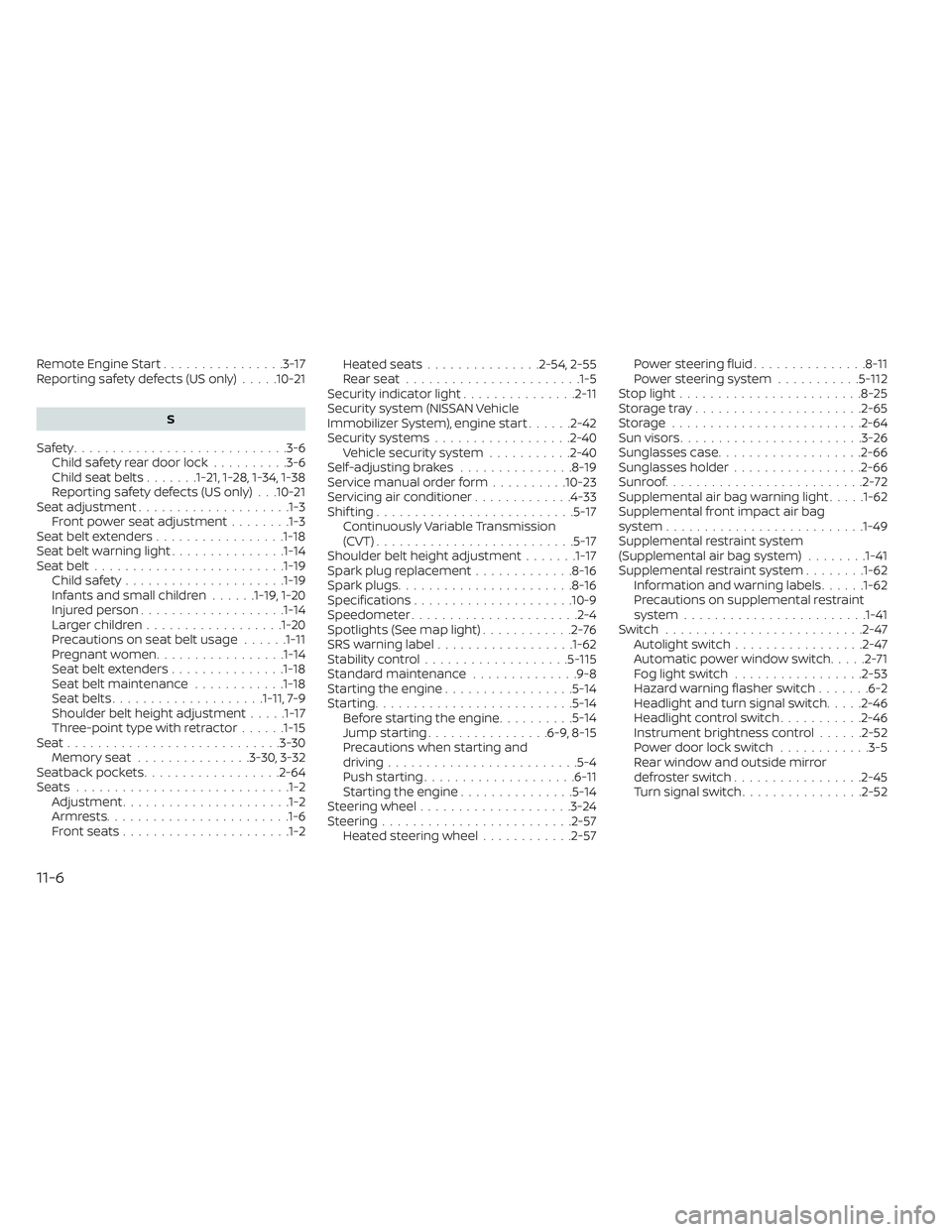
Remote Engine Start................3-17
Reporting safety defects (US only) .....10-21
S
Safety............................3-6
Child safety rear door lock ..........3-6
Childseatbelts.......1-21, 1-28, 1-34, 1-38
Reporting safety defects (US only) . . .10-21
Seat adjustment ....................1-3
Front power seat adjustment ........1-3
Seat belt extenders .................1-18
Seatbeltwarninglight.............. .1-14
Seatbelt.........................1-19 Childsafety.................... .1-19
Infants and small children ......1-19, 1-20
Injuredperson.................. .1-14
Largerchildren................. .1-20
Precautions on seat belt usage ......1-11
Pregnant women .................1-14
Seat belt extenders ...............1-18
Seat belt maintenance ............1-18
Seatbelts................... .1-11, 7-9
Shoulder belt height adjustment .....1-17
Three-pointtypewithretractor......1-15
Seat............................3-30 Memory seat ...............3-30,3-32
Seatback pockets ..................2-64
Seats ........................... .1-2
Adjustment ..................... .1-2
Armrests....................... .1-6
Frontseats..................... .1-2Heatedseats...............2-54,2-55
Rearseat ......................
.1-5
Security indicator light ...............2-11
Security system (NISSAN Vehicle
Immobilizer System), engine start ......2-42
Security systems ..................2-40
Vehicle security system ...........2-40
Self-adjustingbrakes ...............8-19
Service manual order form ..........10-23
Servicing air conditioner .............4-33
Shifting..........................5-17 Continuously Variable Transmission
(CVT) ..........................5-17
Shoulder belt height adjustment .......1-17
Spark plug replacement .............8-16
Spark plugs .......................8-16
Specifications .....................10-9
Speedometer ......................2-4
Spotlights(Seemaplight)............2-76
SRS warning label ..................1-62
Stability control ...................5 -115
Standard maintenance ..............9-8
Starting the engine .................5-14
Starting..........................5-14
Before starting the engine ..........
5-14
Jumpstarting................6-9,8-15
Precautions when starting and
driving.........................5-4
Push starting ....................6-11
Starting the engine ...............5-14
Steering wheel ....................3-24
Steering.........................2-57 Heated steering wheel ............2-57 Powersteeringfluid...............8-11
Powersteeringsystem ...........5
-112
Stoplight........................8-25
Storagetray......................2-65
Storage .........................2-64
Sunvisors........................3-26
Sunglasses case ...................2-66
Sunglasses holder .................2-66
Sunroof ..........................2-72
Supplemental air bag warning light .....1-62
Supplemental front impact air bag
system ......................... .1-49
Supplemental restraint system
(Supplemental air bag system) ........1-41
Supplemental restraint system ........1-62
Information and warning labels ......1-62
Precautions on supplemental restraint
system ....................... .1-41
Switch ..........................2-47 Autolightswitch.................2-47
Automaticpowerwindowswitch.....2-71
Foglightswitch .................2-53
Hazard warning flasher switch .......6-2
Headlight and turn signal switch .....2-46
Headlightcontrolswitch...........2-46
Instrument brightness control ......2-52
Power door lock switch ............3-5
Rear window and outside mirror
defrosterswitch.................2-45
Turn signal switch ................2-52
11-6
Page 483 of 494
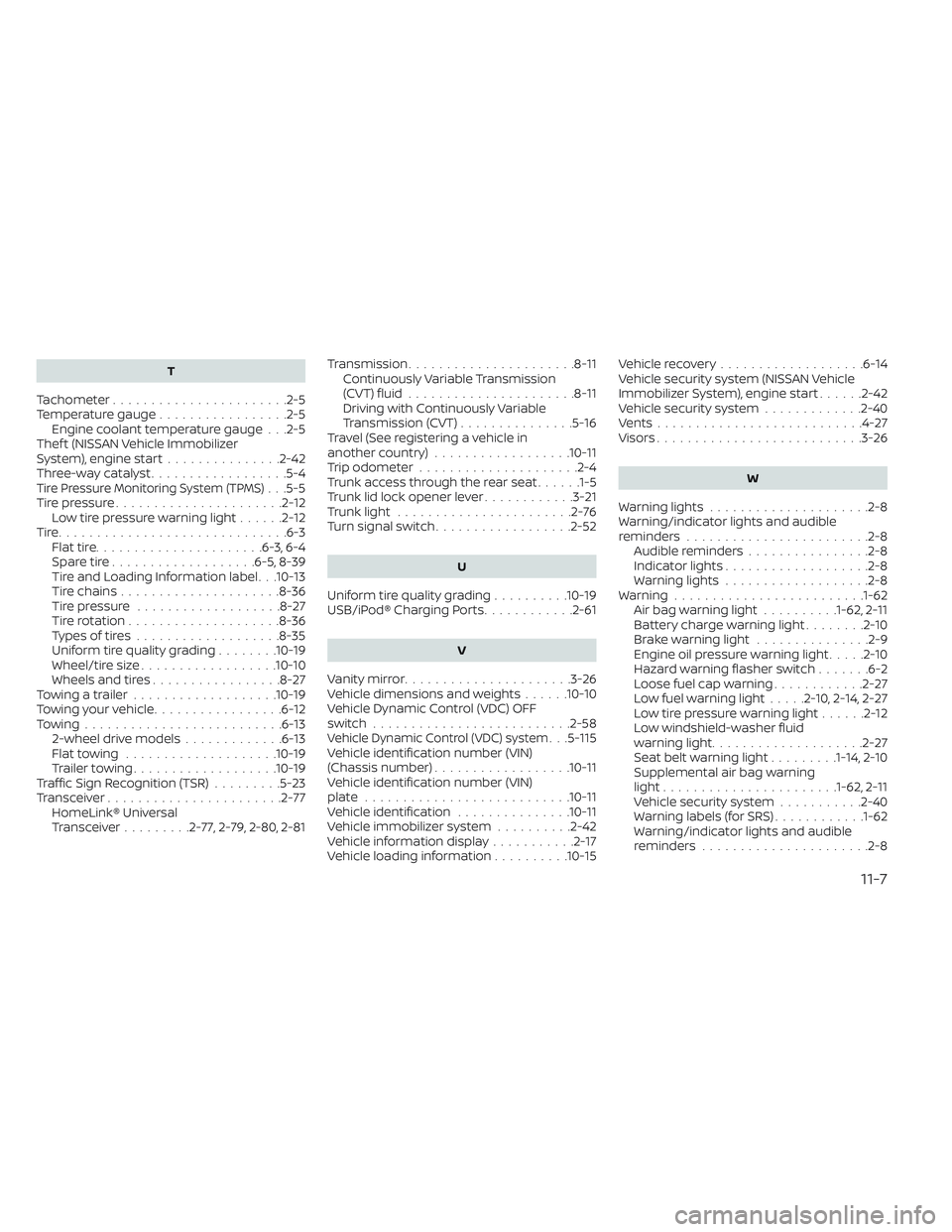
T
Tachometer.......................2-5
Temperature gauge .................2-5
Engine coolant temperature gauge . . .2-5
Thef t (NISSAN Vehicle Immobilizer
System), engine start ...............2-42
Three-waycatalyst..................5-4
Tire Pressure Monitoring System (TPMS)...5-5
Tire pressure ......................2-12
Low tire pressure warning light ......2-12
Tire..............................6-3 Flattire......................6-3,6-4
Spare tire ...................6-5,8-39
Tire and Loading Information label . . .10-13
Tire chains .....................8-36
Tirepressure ...................8-27
Tirerotation....................8-36
Types of tires ...................8-35
Uniform tire quality grading ........10-19
Wheel/tire size ..................10-10
Wheels and tires .................8-27
Towingatrailer ...................10-19
Towingyourvehicle.................6-12
Towing..........................6-13 2-wheel drive models .............6-13
Flattowing ....................10-19
Trailertowing...................10-19
Traffic Sign Recognition (TSR) .........5-23
Transceiver .......................2-77
HomeLink® Universal
Transceiver .........2-77,2-79,2-80,2-81 Transmission
......................8-11
Continuously Variable Transmission
(CVT) fluid ......................8-11
Driving with Continuously Variable
Transmission (CVT) ...............5-16
Travel (See registering a vehicle in
another country) ..................10-11
Trip odometer .....................2-4
Trunk access through the rear seat ......1-5
Trunk lid lock opener lever ............3-21
Trunklight .......................2-76
Turn signal switch ..................2-52
U
Uniform tire quality grading ..........10-19
USB/iPod® Charging Ports ............2-61
V
Vanitymirror......................3-26
Vehicle dimensions and weights ......10-10
Vehicle Dynamic Control (VDC) OFF
switch ..........................2-58
Vehicle Dynamic Control (VDC) system. . .5-115
Vehicle identification number (VIN)
(Chassis number) ..................10-11
Vehicle identification number (VIN)
plate ...........................10-11
Vehicle identification ...............10-11
Vehicle immobilizer system ..........2-42
Vehicleinformationdisplay...........2-17
Vehicle loading information ..........10-15Vehiclerecovery...................6-14
Vehicle security system (NISSAN Vehicle
Immobilizer System), engine start
......2-42
Vehicle security system .............2-40
Vents...........................4-27
Visors.......................... .3-26
W
Warninglights .....................2-8
Warning/indicator lights and audible
reminders........................2-8
Audible reminders ................2-8
Indicatorlights...................2-8
Warninglights ...................2-8
Warning ........................ .1-62
Airbagwarninglight ..........1-62, 2-11
Battery charge warning light ........2-10
Brakewarninglight .............. .2-9
Engine oil pressure warning light .....2-10
Hazard warning flasher switch .......6-2
Loose fuel cap warning ............2-27
Lowfuelwarninglight.....2-10, 2-14, 2-27
Lowtirepressurewarninglight......2-12
Low windshield-washer fluid
warninglight....................2-27
Seatbeltwarninglight.........1-14, 2-10
Supplemental air bag warning
light...................... .1-62, 2-11
Vehicle security system ...........2-40
Warning labels (for SRS) ............1-62
Warning/indicator lights and audible
reminders ......................2-8
11-7
Page 484 of 494
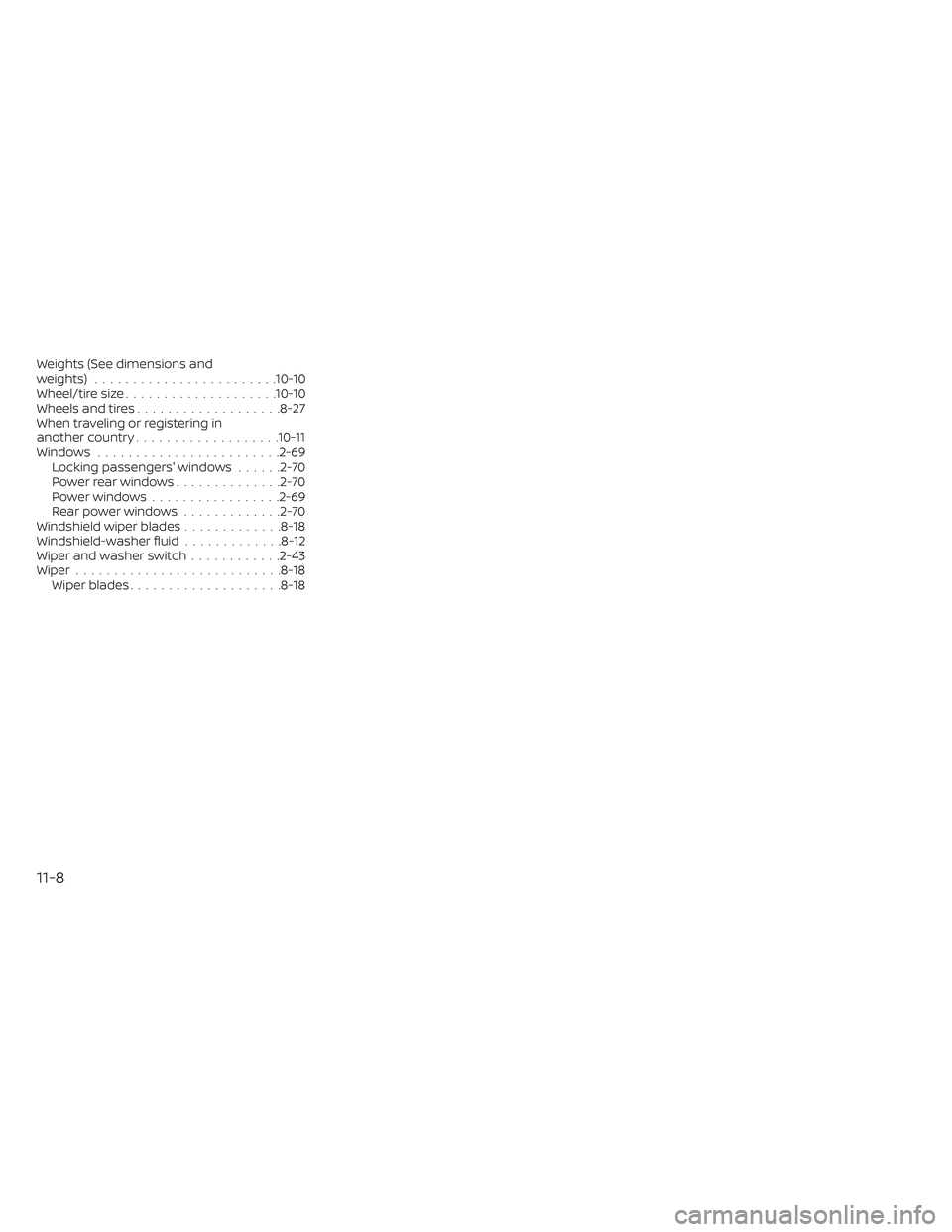
Weights (See dimensions and
weights) ........................10-10
Wheel/tire size....................10-10
Wheels and tires ...................8-27
When traveling or registering in
another country ...................10-11
Windows ........................2-69 Locking passengers' windows ......2-70
Powerrearwindows..............2-70
Powerwindows.................2-69
Rearpowerwindows .............2-70
Windshield wiper blades .............8-18
Windshield-washer fluid .............8-12
Wiper and washer switch ............2-43
Wiper...........................8-18 Wiper blades ....................8-18
11-8
Page 492 of 494
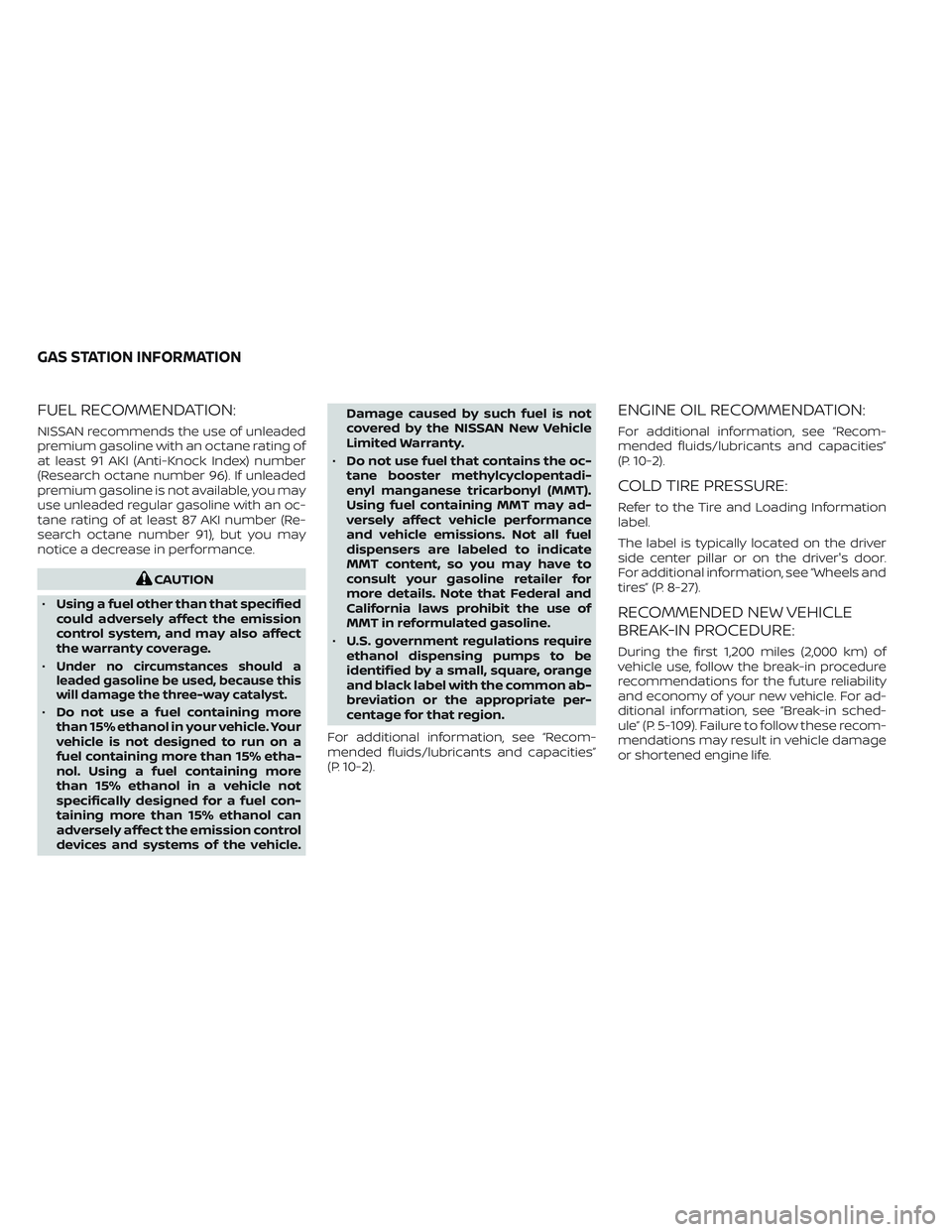
FUEL RECOMMENDATION:
NISSAN recommends the use of unleaded
premium gasoline with an octane rating of
at least 91 AKI (Anti-Knock Index) number
(Research octane number 96). If unleaded
premium gasoline is not available, you may
use unleaded regular gasoline with an oc-
tane rating of at least 87 AKI number (Re-
search octane number 91), but you may
notice a decrease in performance.
CAUTION
• Using a fuel other than that specified
could adversely affect the emission
control system, and may also affect
the warranty coverage.
•
Under no circumstances should a
leaded gasoline be used, because this
will damage the three-way catalyst.
• Do not use a fuel containing more
than 15% ethanol in your vehicle. Your
vehicle is not designed to run on a
fuel containing more than 15% etha-
nol. Using a fuel containing more
than 15% ethanol in a vehicle not
specifically designed for a fuel con-
taining more than 15% ethanol can
adversely affect the emission control
devices and systems of the vehicle. Damage caused by such fuel is not
covered by the NISSAN New Vehicle
Limited Warranty.
• Do not use fuel that contains the oc-
tane booster methylcyclopentadi-
enyl manganese tricarbonyl (MMT).
Using fuel containing MMT may ad-
versely affect vehicle performance
and vehicle emissions. Not all fuel
dispensers are labeled to indicate
MMT content, so you may have to
consult your gasoline retailer for
more details. Note that Federal and
California laws prohibit the use of
MMT in reformulated gasoline.
• U.S. government regulations require
ethanol dispensing pumps to be
identified by a small, square, orange
and black label with the common ab-
breviation or the appropriate per-
centage for that region.
For additional information, see “Recom-
mended fluids/lubricants and capacities”
(P. 10-2).
ENGINE OIL RECOMMENDATION:
For additional information, see “Recom-
mended fluids/lubricants and capacities”
(P. 10-2).
COLD TIRE PRESSURE:
Refer to the Tire and Loading Information
label.
The label is typically located on the driver
side center pillar or on the driver's door.
For additional information, see “Wheels and
tires” (P. 8-27).
RECOMMENDED NEW VEHICLE
BREAK-IN PROCEDURE:
During the first 1,200 miles (2,000 km) of
vehicle use, follow the break-in procedure
recommendations for the future reliability
and economy of your new vehicle. For ad-
ditional information, see “Break-in sched-
ule” (P. 5-109). Failure to follow these recom-
mendations may result in vehicle damage
or shortened engine life.
GAS STATION INFORMATION